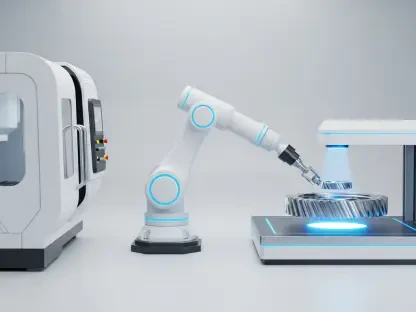The automotive industry is undergoing a digital revolution, and Stellantis is leading the charge with an ambitious strategy to reduce manufacturing costs by utilizing artificial intelligence (AI) and digital technologies. The company’s annual Factory Booster Day event in Turin, Italy, offers a glimpse into the innovations driving this transformation, showcasing how Stellantis is planning to revolutionize their manufacturing and logistics processes. By integrating these advanced technologies, Stellantis aims to significantly enhance productivity and improve customer experiences, with a target of cutting manufacturing costs by 40% by 2030.
AI and Digital Twins: Revolutionizing Factory Planning
One of the cornerstone technologies in Stellantis’ strategy is the use of digital twin technology, a highly advanced method that involves creating a virtual replica of physical systems. Through a partnership with Autodesk, Stellantis is utilizing a cloud-based planning system to create digital twins of their manufacturing facilities. These virtual replicas of their factories allow for precise, efficient, and adaptive factory planning and execution, significantly reducing the likelihood of costly design errors.
Digital twins enable real-time decision-making and efficient planning by simulating different scenarios and identifying optimal solutions. This ability to anticipate and mitigate potential issues before they arise ensures smoother operations and enhances overall productivity. The adaptability and precision offered by digital twins can significantly reduce operational costs, making them an indispensable tool in Stellantis’ strategy for cost reduction. By adopting digital twins, Stellantis is not only expecting to cut down on errors but also drive significant improvements in process efficiency and resource utilization.
AI complements digital twin technology by providing advanced data analytics and machine learning capabilities. These powerful tools help optimize production schedules, predict equipment failures, and automate routine tasks, all of which are integral to improving operational efficiency. AI-driven analytics can process vast amounts of data to identify patterns and insights that might be missed by human analysts, allowing for more informed decision-making. When combined, AI and digital twins form a powerful synergy that enhances efficiency, reduces costs, and increases the resilience of Stellantis’ manufacturing ecosystem.
Automating Plant Logistics for Enhanced Efficiency
Logistics automation is another critical component of Stellantis’ cost reduction strategy, aimed at streamlining operations, reducing errors, and minimizing downtime. By focusing on automating plant logistics, Stellantis is ensuring that material handling processes become more efficient and less dependent on manual labor, which is often prone to errors and inefficiencies. Implementing autonomous mobile robots (AMRs) and AI-driven vision systems are key initiatives in this area, designed to transform and optimize logistics within manufacturing plants.
Autonomous mobile robots are being introduced to handle material transportation within plants. These robots are equipped with advanced navigation systems that enable them to move materials efficiently and accurately. The introduction of these robots reduces the need for manual labor, significantly minimizing the risk of human error and enhancing overall operational efficiency. A key innovation in this area is the integration of flexible, low-cost solutions like wheel.me’s autonomous wheels, which can retrofit existing dollies and transform them into automated transport systems. This approach doesn’t require major infrastructural changes, making it a cost-effective solution for automating material handling processes.
AI-driven vision systems also play a crucial role in automating quality control processes. Through a partnership with Inbolt, Stellantis has integrated AI-driven vision systems that enhance the functionality of existing industrial robots. These systems enable the robots to adapt in real-time to moving parts and detect defects more accurately than traditional methods. This ability to adapt and respond to changes in the production environment ensures high-quality production standards while maintaining operational efficiency. By automating these quality control processes, Stellantis can ensure consistent product quality, reduce the rate of defects, and minimize rework costs.
Strategic Partnerships Driving Technological Innovation
Recognizing the importance of collaboration in driving technological innovation, Stellantis has formed strategic partnerships with several tech firms and startups. These partnerships are central to their strategy, allowing Stellantis to leverage the expertise and cutting-edge solutions developed by these innovators. This collaborative approach accelerates the implementation of advanced technologies and ensures that Stellantis remains at the forefront of digital manufacturing.
One notable partnership is with Autodesk, whose cloud-based planning system provides Stellantis with state-of-the-art digital twin technology. By partnering with Autodesk, Stellantis gains access to sophisticated tools that enable efficient factory planning and execution. This collaboration with Autodesk ensures that Stellantis can utilize digital twins to their full potential, transforming their factory planning processes and enhancing overall operational efficiency.
Another significant partnership is with Inbolt, a company specializing in AI-driven vision systems. Inbolt’s technology offers real-time adaptability for industrial robots, enhancing their precision and efficiency in various manufacturing tasks. By incorporating Inbolt’s solutions, Stellantis can optimize its manufacturing processes without the need for extensive infrastructure overhauls, making it a practical and scalable solution for enhancing production quality and efficiency. These strategic partnerships reflect Stellantis’ commitment to fostering a culture of innovation and continuous improvement.
These collaborations are a testament to Stellantis’ forward-thinking approach to technology adoption. By engaging with tech innovators, Stellantis is able to implement scalable and practical solutions that drive significant cost savings and operational improvements. This collaborative approach not only accelerates the pace of innovation but also ensures that Stellantis can adapt to new technological advancements swiftly and effectively.
Incremental Innovations for Energy and Quality Improvements
Since 2021, Stellantis has been committed to making incremental innovations aimed at improving energy consumption, transformation costs, and quality management. This approach focuses on practical, manageable changes that can be implemented without causing major disruptions to existing processes. These incremental improvements are a key part of Stellantis’ strategy to achieve long-term cost savings and operational efficiencies.
One major area of focus for Stellantis is energy efficiency. The company is implementing a range of energy-saving technologies and optimizing production processes to reduce energy consumption. These efforts are not only aimed at lowering operational costs but also at contributing to Stellantis’ broader sustainability goals. By reducing energy usage, Stellantis can lower its environmental footprint while also achieving significant cost savings.
Quality management is another critical aspect of Stellantis’ strategy for continuous improvement. The company is leveraging AI and digital technologies to enhance its quality control processes. By automating quality inspections and utilizing advanced data analytics, Stellantis is able to identify and address potential issues more effectively. This proactive approach ensures consistent product quality, reduces the rate of defects, and minimizes the need for costly rework. These incremental improvements in quality management are essential for maintaining high production standards and enhancing customer satisfaction.
These efforts demonstrate Stellantis’ strong commitment to continuous enhancement and innovation. By focusing on small, scalable changes, the company can achieve significant improvements in efficiency and cost savings over time. This approach ensures that Stellantis can adapt to new challenges and opportunities in the evolving automotive industry while maintaining steady progress toward its ambitious cost reduction goals.
Practicality and Flexibility in Implementation
The automotive industry is seeing a digital revolution, and Stellantis is at the forefront with a bold strategy to cut manufacturing costs by harnessing artificial intelligence (AI) and digital technologies. At their annual Factory Booster Day event in Turin, Italy, Stellantis reveals the innovations that are transforming their manufacturing and logistics processes. By integrating advanced technologies, the company plans to boost productivity and improve customer experiences, ultimately aiming to reduce manufacturing costs by 40% by 2030.
Stellantis is leveraging AI to streamline various aspects of production, from supply chain management to assembly lines. This allows for more efficient use of resources and reduction in waste. The company is also focusing on smart manufacturing techniques and the Internet of Things (IoT) to gather real-time data, enabling predictive maintenance and minimizing downtime.
The advancements showcased during Factory Booster Day highlight Stellantis’ commitment to embracing cutting-edge technology to stay competitive. With a clear vision for the future, Stellantis is not only aiming to cut costs but also to set new standards in automotive manufacturing. Through these efforts, the company seeks to offer better products and services to their customers while maintaining operational efficiency and sustainability.









